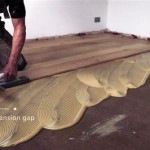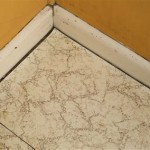Can You Lay Laminate Wood Flooring Over Ceramic Tile?
Laminate wood flooring presents a readily available and often cost-effective alternative to solid hardwood. Its click-lock installation system makes it appealing to both DIY enthusiasts and professional installers. A common question that arises during a flooring renovation concerns the feasibility of installing laminate directly over existing ceramic tile. The answer is not a simple "yes" or "no," as multiple factors influence the success and suitability of such an installation.
The primary advantage of installing laminate over existing tile is the potential to save time and labor costs associated with removing the old tile. Tile removal can be a messy, time-consuming, and potentially hazardous process, generating significant dust and requiring specialized tools. Overlaying the tile avoids these issues. However, careful assessment and preparation are crucial to ensure a stable, level, and aesthetically pleasing final floor.
Key Considerations Before Installation
Several key points must be considered before deciding to lay laminate wood flooring over ceramic tile. These factors will determine whether the project is feasible and whether the resulting floor will meet expectations in terms of appearance, durability, and longevity.
1. Tile Condition and Levelness: The existing ceramic tile floor must be in good condition. Loose, cracked, or broken tiles need to be repaired or replaced. Ideally, the surface should be as level as possible. Laminate flooring requires a relatively flat subfloor to prevent flexing, squeaking, and potential damage to the locking mechanisms. Unevenness can lead to stress points in the laminate, causing the planks to separate or break over time. Minor variations can sometimes be addressed with self-leveling compound, but significant dips or humps will likely require more extensive leveling measures.
To assess levelness, use a long straightedge (at least 6 feet) and a level. Place the straightedge across different areas of the floor and check for gaps between the straightedge and the tile surface. Any gaps exceeding the tolerance specified by the laminate flooring manufacturer (usually around 3/16 inch over a 10-foot span) require correction. For smaller imperfections, self-leveling compound can be applied to fill in low spots. Larger variations may necessitate grinding down high spots or applying a thicker layer of self-leveling compound, which can be more costly and time-consuming.
2. Moisture Management: Moisture is a significant enemy of laminate flooring. Laminate is susceptible to warping, swelling, and mold growth if exposed to excessive moisture. Ceramic tile is generally impervious to water, but moisture can still be a concern if there are cracks in the grout lines or if the underlying subfloor is prone to dampness. Before installing laminate, thoroughly inspect the grout lines for cracks and repair them as needed. In areas with high humidity or a history of moisture problems, consider installing a moisture barrier over the tile before laying the underlayment and laminate. This barrier acts as a protective layer, preventing moisture from migrating upwards and damaging the laminate.
A common method for assessing moisture levels involves using a moisture meter. These devices can measure the moisture content of the subfloor. If the moisture level is above the manufacturer's recommended threshold for laminate installation, further investigation is warranted. This may involve checking for plumbing leaks, ensuring proper ventilation in the room, and addressing any underlying drainage issues.
3. Doorway Clearances: Adding laminate flooring over existing tile will raise the floor height. This can create problems with door clearances, especially if doors already fit snugly within their frames. Before proceeding, measure the clearance between the bottom of the doors and the existing tile floor. The thickness of the laminate flooring plus the underlayment will determine the total height increase. If the doors will not have sufficient clearance after the laminate is installed, they will need to be trimmed or shaved down. This is a relatively straightforward task but requires careful planning and execution to avoid damaging the doors.
Beyond doorways, also consider the impact on transitions to other flooring types. The height difference between the laminate floor and adjacent rooms should be minimized to prevent tripping hazards. Transition strips can be used to bridge these height differences, but it’s important to select strips that are appropriate for the specific height variation and flooring materials.
Preparation and Installation Process
Assuming that the tile floor is in suitable condition and the necessary clearances have been addressed, the preparation and installation process is critical for a successful outcome.
1. Cleaning and Repair: Begin by thoroughly cleaning the tile floor to remove all dirt, dust, grease, and debris. Use a degreasing cleaner to ensure that the surface is completely clean. Repair any cracked or loose tiles using appropriate adhesives and grout. Allow the repairs to fully cure before proceeding to the next step.
2. Underlayment Installation: Underlayment is an essential component of a laminate flooring installation. It provides cushioning, sound insulation, and a moisture barrier (if the underlayment is designed to do so). The underlayment is laid directly over the tile floor, providing a smooth and stable surface for the laminate. Choose an underlayment that is specifically designed for use with laminate flooring and that is compatible with the existing tile surface. Some underlayments have a built-in moisture barrier, while others require a separate moisture barrier to be installed underneath. Follow the manufacturer's instructions for installing the underlayment, ensuring that it is properly aligned and taped at the seams.
3. Laminate Flooring Installation: Once the underlayment is in place, the laminate flooring can be installed according to the manufacturer's instructions. Start in a corner of the room and work your way across, clicking the laminate planks together. Use spacers along the walls to allow for expansion and contraction of the flooring due to temperature and humidity changes. Avoid forcing the planks together, as this can damage the locking mechanisms. Use a tapping block and a hammer to gently tap the planks into place.
4. Trimming and Finishing: As you reach the edges of the room, you will likely need to cut the laminate planks to fit. Use a saw to make precise cuts, ensuring that the edges are clean and straight. Install transition strips at doorways and where the laminate floor meets other flooring types. Install baseboards or quarter-round molding along the walls to cover the expansion gap and to provide a finished look.
Potential Challenges and Solutions
Even with careful planning and preparation, several challenges can arise during the installation process.
1. Uneven Tile Surfaces: As previously mentioned, uneven tile surfaces can cause problems with laminate flooring. If the tile floor is significantly uneven, self-leveling compound may not be sufficient to correct the problem. In this case, consider using a thicker underlayment or installing a layer of plywood over the tile to create a more level surface. However, be aware that adding plywood will further increase the floor height and may require additional adjustments to doorways and transitions.
2. Moisture Issues: Moisture can be a persistent problem, especially in basements or areas with poor ventilation. If you suspect that moisture is present, take steps to identify and address the source of the moisture before installing the laminate flooring. This may involve repairing leaks, improving ventilation, or installing a dehumidifier. Use a high-quality moisture barrier under the underlayment to protect the laminate from moisture damage.
3. Squeaking Floors: Squeaking can occur if the laminate flooring is not properly supported or if there is friction between the laminate planks and the underlying tile surface. Ensure that the underlayment is properly installed and that the laminate planks are securely clicked together. If squeaking persists, try lubricating the joints between the planks with a silicone-based lubricant.
Alternative Solutions
If the challenges associated with installing laminate over ceramic tile seem too daunting, alternative flooring options should be considered. Removing the existing tile and installing laminate directly on the subfloor is one option, although this can be a labor-intensive and messy process. Another option is to install a different type of flooring, such as vinyl plank flooring, which is more flexible and forgiving than laminate and can often be installed over slightly uneven surfaces. Vinyl is also generally more moisture-resistant than laminate, making it a better choice for areas with high humidity or potential moisture problems.
Ultimately, the decision of whether or not to install laminate wood flooring over ceramic tile depends on a careful assessment of the existing tile floor, the desired outcome, and the potential challenges involved. Thorough preparation and proper installation techniques are essential for a successful and long-lasting result.

Can You Put Laminate Flooring Over Tile Twenty Oak

Should You Install Vinyl Floor Over Tile

New Vinyl Plank Flooring Over Tile Table And Hearth

How To Combine Tile And Wood Flooring Rubi Blog Usa

What Type Of Flooring Can You Install Over Ceramic Tile

What Type Of Flooring Can You Install Over Ceramic Tile
Ideas For Covering Up Tile Floors Without Removing It The Decor Formula

Install Hardwood Flooring Over Tile Floor Double Glue Down Method

Common Mistakes When Laying Laminate Flooring Next Day Floors

Can Vinyl Flooring Be Laid Over Laminate Go For Floors
Related Posts








